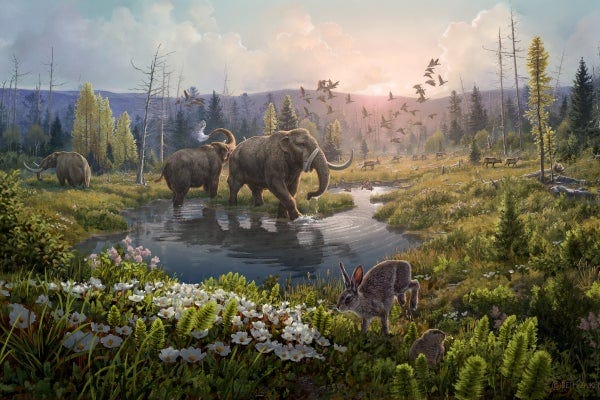Could the Resurrection of Mammoths Help Combat Climate Change?
Written on
The Promise of Pleistocene Park
Could the revival of extinct species like the woolly mammoth offer solutions to climate change? The concept seems far-fetched but has gained traction among scientists and entrepreneurs alike.

Photo Credit: Illustration by Julia Wytrazek / Getty Images
Initially, I was quite skeptical after watching a documentary that won an award in 2022. However, the scientific developments in this field are proving to be promising and perhaps even accelerating. Discussions about reviving the woolly mammoth have been ongoing since my middle school days, and what was once considered science fiction is steadily becoming a reality.
Advancements in Genetic Engineering
Recently, a biotech firm based in Dallas, Colossal Laboratories and Biosciences, made headlines by successfully transforming cells from an Asian elephant into induced pluripotent stem cells (iPSCs). This is a significant breakthrough, as pluripotent cells can develop into various cell types needed for mammoth revival.
The next steps involve turning these stem cells into egg and sperm cells, alongside selecting genetic traits tied to the mammoth. Successful gestation is also a critical factor. While this process is complex, it is certainly more feasible than resurrecting dinosaurs.
Colossal Labs may not be an official partner of Pleistocene Park, but they are collaborating to extract frozen mammoth DNA from the permafrost for their ambitious project.
The Vision for Pleistocene Park
The primary goal of Pleistocene Park is to reverse the ecological changes that took place roughly 10,000 years ago. By increasing herbivore populations in the Arctic, scientists aim to restore historic grasslands and create a self-sustaining ecosystem that can prevent permafrost from melting.
Initially a dream in 1996, Pleistocene Park is slowly evolving into a reality as Sergei and Nikita Zimov actively seek Ice Age species to introduce into the park.

Photo Credit: Reconstruction of Kap København formation two million years ago, showcasing a warmer climate than today's northern Greenland.
The Zimovs aspire to transform the Arctic tundra back into a mammoth steppe, featuring diverse grasses, herbs, and other flora that can thrive on frozen ground. Such a transformation could significantly slow down permafrost thawing, providing governments with additional time to implement effective carbon-saving strategies.
The disappearance of the mammoth tundra steppe at the start of the Holocene epoch can be attributed to a combination of climate change and early human hunting practices, which disrupted the delicate balance of Arctic ecosystems.
Encouragingly, historical evidence suggests that other Arctic species have successfully adapted when reintroduced into their native environments. For instance, bison and musk oxen have thrived in Alaska, and horses now constitute a significant portion of the biomass in the Republic of Yakutia, home to Pleistocene Park.
The Ecological Benefits of Herbivores
Currently, Pleistocene Park spans 20 square kilometers (approximately 8 square miles) and hosts nine major herbivore species, including reindeer, Yakutia horses, moose, bison, musk ox, Kalmykia cows, sheep, camels, and goats. Unlike warmer regions, these Arctic herbivores can have a cooling effect on the climate through several mechanisms.
When these animals forage during winter, they compress the snow, which disrupts its insulating properties, allowing deeper freezing of the ground. Additionally, grasslands, being lighter in color than shrublands or forests, reflect more sunlight back into space, contributing to a cooling effect known as the Albedo effect. Moreover, the deep root systems of traditional grasses help sequester carbon, preventing its release into the atmosphere.
Challenges of De-extinction
However, the reintroduction of mammoths and other Pleistocene species is not without challenges. The current atmospheric oxygen level is 20%, compared to 16.5% during the Pleistocene. There are also concerns about the microbes that once inhabited mammoths' guts and their potential impact on the ecosystem.
The complexities of this endeavor raise ethical questions about the consequences of "playing God." According to Colossal's timeline, it could take until the mid-century before any engineered mammoths roam the Siberian steppe, by which time we should ideally be on track for a carbon-neutral planet.
Despite these challenges, the research team at Pleistocene Park has observed a gradual transition from shrublands to grasslands in the Siberian tundra over the last twenty years, alongside increased carbon storage and nutrient cycling. If we miss the critical 2050 carbon-neutral deadline, perhaps groundbreaking science could still offer a path to redemption.
Thank you for engaging with this exploration! Did you know you can join Medium?
Be a Reader or Become a Writer


Research References
Protection of Permafrost Soils from Thawing by Increasing Herbivore Density - PubMed
Climate change will cause a substantial future greenhouse gas release from warming and thawing permafrost-affected…
pubmed.ncbi.nlm.nih.gov
World's Oldest DNA Discovered, Revealing Ancient Arctic Forest Full of Mastodons
Two-million-year-old DNA, the world's oldest, reveals that mastodons once roamed forests in Greenland's far northern…
scientificamerican.com
Welcome to the Future Range of the Woolly Mammoth
In Arctic Siberia, Russian scientists are trying to stave off catastrophic climate change by resurrecting an Ice Age…
www.theatlantic.com
Video Insights
In this video, learn the complete game rules for "How to Play Evolution: Climate" in just 20 minutes, highlighting the interconnectedness of climate and evolutionary changes.
Explore the question of whether evolution has driven us to change the climate in this thought-provoking video.